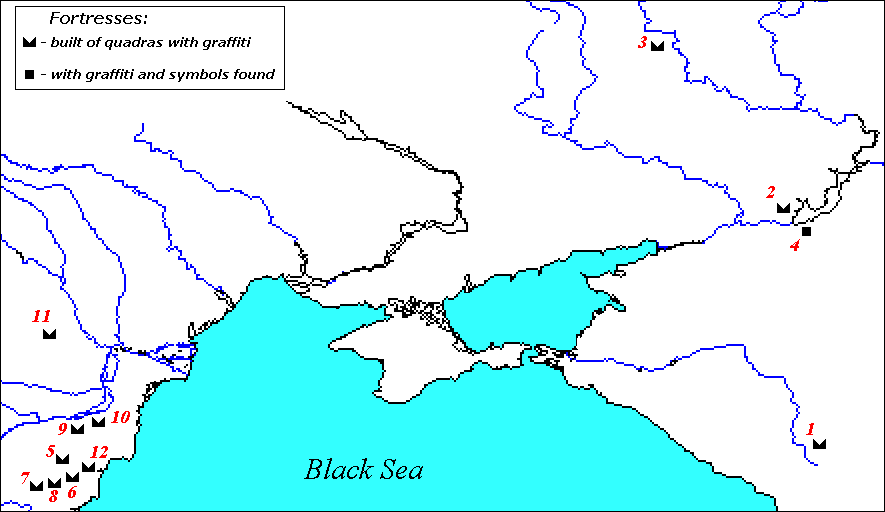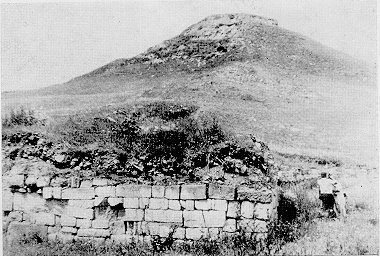Russian version needs a translation
Humarin Citadel
|
Links |
|
Summary |
|
The finds in the mountain valleys of Kabardino-Balkaria are
scarce. But there Humarin
citadel is a remarkable center of the Kuban Bulgars in the upper course of
the Kuban river. It is situated on the high right bank of Kuban near aul
Humara 11 km north of the town Karachaevsk. The fortress
guarded the approaches to the Kluhor pass, which connects the Kuban valley with
Sukhumi on the Black Sea coast.
Fig. 1 Map of Bulgarian fortresses in Eastern Europe and
on Lower Danube, built of ashlar blocks and with inscriptions
The citadel occupies a narrow and long hill surrounded by deep ravines and is linked with the high plateau by a narrow neck. The area enclosed by the walls is 840 m long and 480 m wide, or nearly 40 hectares. Kuznetsov published several runic inscriptions and symbols from Humarin in 1963, and since 1974 there were systematic archaeological excavations. The excavations revealed a 5-6 m thick fortified wall running at the edge of the hill, built of ashlar blocks with dimensions 0.9 x 0.4 x 0.3 m and 0.5 x 0.35 x 0.2 m, sometimes up to 1.4 x 0.3 x 0.2 m. The blocks were larger near the towers and at the lower part of the walls. These were no foundations, the walls are laid directly on the leveled ground. The facing was always of carefully cut rock blocks, the inner volume of the wall being filled with irregular blocks. Usually the first row of ashlars was laid crosswise, the next row - lengthwise, and so on. Clay was the main binding agent, mortar was used only for the outer lower facing wall. There were 20 equidistant towers along the wall and the high point in the eastern end of the fortress was built as a inner citadel. Fig. 2 The Humarin Citadel. In front is the ashlar block tower next to the gate. At the far end - the inner citadel of the fortress.
Next to the rectangular tower in the south-western end of the fortress, at the foot of the citadel was unearthed a small, but intriguing building, built later than the fortress. It represents a rectangular single chamber, 7 m long and 6.2 m wide. Its 0.75-1.0 m thick walls consist of very elaborately cut ashlar blocks. In the center of the room is a leveled square platform (2.5 x 2.4 m), shouldered by a double line of ashlar blocks. The clayey platform bears the signs of fire and the whole building is oriented towards the summer sunrise. All points that it had religious functions, it can be compared with Zoroastrian shrines in which the altar with a burning fire occupied a central place. The religious beliefs of the population of the town of Varachan, the capital of the 'Kingdom of the Huns', illustrated the religious syncretism between the principal Türkic deity Tengri, Tangri-Khan and the Iranian god of the sun Kuara. We may suppose that the worshipers of Tangri-Khan adopted the plan for the religious building, and some elements of the fire cult of the Zoroastrians. This concept is confirmed by a number of archaeological finds from the political and religious centers of the Danube Bulgaria. In its first capital Pliska, the residence of the Bulgarian rulers, is a similar building, with two squares of ashlars, one inside the other. A second, much larger building, oriented towards the sunrise, was excavated near the Throne palace in Pliska. Its religious nature is confirmed by the fact that after the adoption of Christianity the building was transformed into a Christian church (the so called Palace church). Similar buildings are also found in Preslav. Similar in plan is the pagan sanctuary at the Bulgarian religious complex of Madara, near Daul-Tash. |
|
References |
|
V.A. Kuznetsov. Nadpisi Humarnskogo gorodishta. - Sovetskaja Arheologija, 1963, No 1, p. 298-305. |

